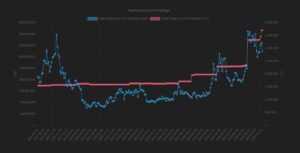Bitcoin’s mining difficulty has dropped off a cliff, falling 27.9% as the network adjusts to the China-led drop in hash rate.
This is the largest decrease in mining difficulty since the network went live in 2009 – ticking higher than last week’s estimates.
In Brief
- The Bitcoin network’s mining difficulty has decreased, adjusting for the recent drop in hash rate.
- This latest difficulty adjustment was the largest one in recorded history.
- BTC could print
Cryptocurrencies aren’t going away. Buy Bitcoin here.
The Bitcoin network updates its mining difficulty level after every 2,016 recorded blocks, which happens about every two weeks. The design is deliberate in order to make sure that blocks are produced every ten minutes or so, despite a fluctuating hash rate hailing from deliberate (but ultimately futile) attempts to stifle the network.
In this case, the hash rate has been incredibly volatile as miners relocate to greener pastures outside of China. Since the previous adjustment on June 13, Bitcoin’s seven-day moving average hash rate has fallen from 136.47 EH/s to 85 EH/s — down 35%. The full recovery will likely take several weeks as Bitcoin’s hash rate slowly creeps back from the lows. Over time, bitcoin will also print new all time highs in its hashing power.
Bitfury group co-founder George Kikvadze suggested that it could take anywhere between 9-12 months before Bitcoin’s hash rate hits new all time highs due to the scale of the operation, with the biggest bottlenecks being ‘energy availability and readiness’.

As noted, the sharp downturn was caused by a crackdown on bitcoin mining in China, which forced miner operations to migrate to friendlier jurisdictions elsewhere – the United States being one of them.
This lower hash rate led to a slower rate of block production as the remaining hashing power was unable to keep up with the high difficulty level. For the last two weeks, blocks were produced nearly every 13.9 minutes on average, much higher than usual, based on The Block’s calculation.
On July 1, it even took 129 minutes to produce a block, the longest time since 2011, although it’s worth noting that multiple factors come into play here, including the inherent variance in block times.
Subscribe to the semi-weekly newsletter for regular insight into bitcoin and crypto. Go on. It’s free.
Join the telegram channel for updates, charts, ideas and deals.
Did you like the article? Share it!


